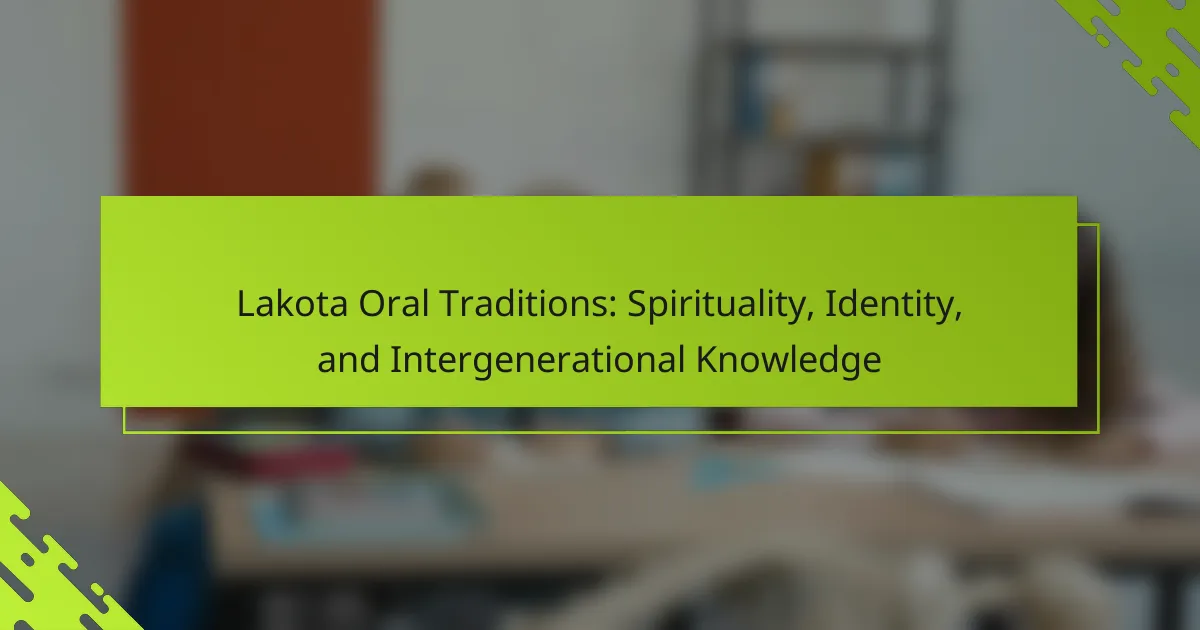Lakota oral traditions play a crucial role in preserving spirituality, identity, and intergenerational knowledge. These traditions transmit values and historical narratives, fostering community cohesion. Elders share cultural teachings through storytelling, while contemporary issues threaten their preservation. Engaging youth and celebrating oral history are vital for maintaining these essential practices.

What role do oral traditions play in Lakota spirituality?
Lakota oral traditions are central to spirituality, shaping identity and preserving intergenerational knowledge. They convey teachings, values, and cultural practices, fostering a deep connection to the land and ancestors. Storytelling serves as a spiritual guide, reinforcing communal bonds and identity. Through oral traditions, wisdom is passed down, ensuring cultural continuity and resilience.
How do stories shape spiritual beliefs and practices?
Stories profoundly shape spiritual beliefs and practices within Lakota oral traditions by transmitting values and identity. These narratives connect individuals to their ancestors and the natural world, fostering a sense of belonging. They encapsulate teachings that guide moral conduct and spiritual understanding, ensuring intergenerational knowledge transfer. Unique attributes of these stories include their emphasis on harmony with nature and community, which are essential for maintaining cultural integrity. As a result, storytelling becomes a vital practice that reinforces spiritual beliefs and nurtures identity among the Lakota people.
Which key narratives are central to Lakota spiritual identity?
Central narratives of Lakota spiritual identity include the connection to the land, the significance of the buffalo, and the importance of vision quests. These elements shape their worldview and cultural practices. The Lakota view the land as sacred, which fosters a deep relationship with nature. The buffalo represents sustenance and spiritual guidance, emphasizing interdependence. Vision quests serve as rites of passage, facilitating personal and communal identity formation. Together, these narratives reinforce the Lakota’s unique spiritual framework and intergenerational knowledge transmission.

How do Lakota oral traditions contribute to cultural identity?
Lakota oral traditions significantly contribute to cultural identity by preserving spirituality and intergenerational knowledge. These traditions transmit values, beliefs, and historical narratives essential for community cohesion. Storytelling fosters a sense of belonging and continuity among the Lakota people. Additionally, oral traditions serve as a vehicle for teaching younger generations about their heritage, ensuring that unique cultural attributes remain vibrant and relevant.
What are the main themes reflected in Lakota storytelling?
Lakota storytelling reflects themes of spirituality, identity, and intergenerational knowledge. These narratives convey deep connections to nature and the spiritual world, emphasizing the importance of community and cultural heritage. Stories often illustrate moral lessons and the values that shape Lakota identity. Intergenerational transmission of knowledge ensures cultural continuity, with elders sharing wisdom through traditional tales. This storytelling practice reinforces social bonds and collective memory among the Lakota people.
How do oral traditions foster community cohesion among the Lakota?
Lakota oral traditions foster community cohesion by preserving shared values, beliefs, and history. These narratives create a collective identity, strengthening bonds among members. Storytelling serves as a medium for intergenerational knowledge transfer, ensuring cultural continuity. Additionally, rituals associated with these traditions reinforce social ties, enhancing communal support and collaboration.

In what ways are Lakota oral traditions transmitted across generations?
Lakota oral traditions are transmitted through storytelling, ceremonies, and mentorship. Elders play a crucial role in sharing cultural narratives, values, and spiritual beliefs. These practices foster identity and community cohesion among generations. The unique attribute of Lakota oral traditions is their adaptability, allowing them to evolve while preserving core teachings.
What methods do elders use to teach younger generations?
Elders teach younger generations through storytelling, ceremonies, and hands-on activities. These methods preserve Lakota spirituality and identity while transmitting intergenerational knowledge. Storytelling conveys lessons and cultural values, often featuring ancestral figures. Ceremonies, such as the Sun Dance, reinforce community bonds and shared beliefs. Hands-on activities, like crafting traditional items, engage youth in practical learning and skill development. This holistic approach fosters a deep connection to heritage and strengthens cultural continuity.
How does the role of storytelling evolve in modern Lakota communities?
Storytelling in modern Lakota communities serves as a vital tool for preserving spirituality, identity, and intergenerational knowledge. It has evolved to incorporate contemporary issues while maintaining traditional narratives.
Storytelling fosters community cohesion and cultural pride, allowing younger generations to connect with their heritage. This practice also adapts to modern platforms, such as social media, enhancing outreach and engagement.
Unique attributes of Lakota storytelling include the use of personal experiences and collective memories, which reinforce identity. Rarely, stories may integrate contemporary themes, reflecting current challenges and aspirations.
As a result, storytelling remains a dynamic force in Lakota culture, bridging past and present while nurturing future generations.

What unique attributes distinguish Lakota oral traditions from other Indigenous narratives?
Lakota oral traditions are distinguished by their focus on spirituality, communal identity, and the transmission of intergenerational knowledge. These narratives emphasize a deep connection to nature and the cosmos, reflecting unique cultural values. The use of storytelling as a means of teaching moral lessons and preserving history sets them apart from other Indigenous narratives. Additionally, the integration of songs, rituals, and ceremonies within these oral traditions enhances their spiritual significance. This multifaceted approach fosters a strong sense of belonging and continuity among the Lakota people.
How do specific cultural symbols enhance the storytelling experience?
Cultural symbols significantly enhance storytelling in Lakota oral traditions by conveying spirituality, identity, and intergenerational knowledge. These symbols serve as powerful tools that connect narratives to cultural values and ancestral wisdom.
For instance, symbols like the buffalo represent sustenance and community, reinforcing the importance of harmony with nature. The use of colors and patterns in storytelling also reflects deeper meanings tied to identity and spiritual beliefs.
Moreover, these symbols facilitate the transmission of knowledge across generations, ensuring that cultural heritage remains alive. By embedding these elements within stories, Lakota traditions foster a sense of belonging and continuity among community members.
What are the distinct forms of oral expression found in Lakota traditions?
Lakota oral traditions encompass distinct forms of expression, including storytelling, songs, prayers, and rituals. Storytelling conveys cultural history and values, while songs often celebrate nature and spirituality. Prayers serve as a means of communication with the spiritual realm, and rituals reinforce community bonds and identity. Each form plays a crucial role in preserving intergenerational knowledge and maintaining the Lakota identity.

How do contemporary issues impact the preservation of Lakota oral traditions?
Contemporary issues significantly threaten the preservation of Lakota oral traditions. Factors such as cultural assimilation, technological influence, and socioeconomic challenges disrupt intergenerational knowledge transfer.
Cultural assimilation pressures younger generations to adopt dominant narratives, often sidelining traditional storytelling. This shift results in diminished spiritual connections to their heritage.
Technological advancements, while beneficial, can lead to a reliance on digital mediums, potentially replacing oral practices. As a result, the authenticity and depth of these traditions may be lost.
Socioeconomic challenges create barriers to cultural engagement. Limited access to resources can hinder community gatherings, reducing opportunities for sharing stories and fostering identity.
What challenges do Lakota communities face in maintaining their oral histories?
Lakota communities face significant challenges in maintaining their oral histories, including cultural assimilation and loss of language. The influence of modern society often dilutes traditional practices. Additionally, limited resources for education and preservation hinder intergenerational knowledge transfer. The aging population of storytellers further complicates the continuity of these vital traditions.
How are technology and media being utilized to support oral tradition preservation?
Technology and media are vital in preserving Lakota oral traditions by enabling documentation and sharing. Digital platforms allow for the recording of stories, songs, and rituals, ensuring accessibility for future generations. Social media facilitates community engagement and awareness, while educational apps promote intergenerational knowledge transfer. These tools help maintain cultural identity and spirituality, reinforcing the significance of oral traditions in Lakota society.
What initiatives exist to promote intergenerational knowledge sharing?
Various initiatives promote intergenerational knowledge sharing within Lakota oral traditions. These include community storytelling events, mentorship programs, and cultural workshops that foster dialogue between elders and youth.
Community storytelling events allow elders to share spiritual narratives and cultural practices, reinforcing identity and continuity. Mentorship programs connect young individuals with experienced community members, facilitating personal growth and cultural understanding. Cultural workshops provide hands-on experiences in traditional crafts and practices, encouraging active participation and learning.
These initiatives help preserve unique attributes of Lakota culture while promoting intergenerational bonds. The emphasis on oral traditions highlights the significance of storytelling in maintaining spiritual and cultural identity.

What best practices can be adopted for honoring and preserving Lakota oral traditions?
To honor and preserve Lakota oral traditions, communities should prioritize active storytelling, intergenerational mentorship, and cultural education. These practices ensure the transmission of spiritual beliefs and identity across generations.
Engaging youth through workshops fosters a deeper understanding of narratives. Recording stories digitally can safeguard them for future generations. Collaborating with cultural institutions enhances visibility and respect for Lakota traditions.
Community gatherings that celebrate oral history strengthen bonds and reaffirm cultural identity. Encouraging participation in traditional ceremonies helps maintain the relevance of these stories in contemporary contexts.
Which strategies foster effective storytelling in educational settings?
Effective storytelling in educational settings can be fostered through the integration of Lakota oral traditions, emphasizing spirituality, identity, and intergenerational knowledge. These strategies include the use of narrative techniques that connect learners to their cultural heritage.
Incorporating personal stories enhances engagement and facilitates emotional connections. Utilizing traditional storytelling forms, such as the use of metaphors and symbolism, deepens understanding of complex concepts. Additionally, encouraging collaborative storytelling among students promotes shared learning experiences and strengthens community bonds.
Intergenerational knowledge transfer is vital; inviting elders to share their stories enriches the educational experience. This approach not only preserves cultural identity but also instills values and life lessons. Emphasizing spirituality within narratives can inspire reflection and personal growth among students, creating a holistic learning environment.
How can non-Lakota individuals respectfully engage with Lakota oral traditions?
Non-Lakota individuals can respectfully engage with Lakota oral traditions by prioritizing listening, learning, and honoring the culture. Understanding the significance of storytelling in preserving spirituality and identity is essential.
Seek opportunities to learn from Lakota elders and community members. Participate in workshops or cultural events that focus on oral traditions. Approach these experiences with humility and an open mind.
Recognize the unique attributes of Lakota oral traditions, such as their role in conveying intergenerational knowledge and fostering community bonds. Avoid appropriation by acknowledging the origins and context of the stories shared.
Support Lakota artists and storytellers by promoting their work and respecting their intellectual property. Engaging with Lakota oral traditions should be a collaborative and respectful process that values the voices of the community.
